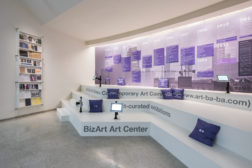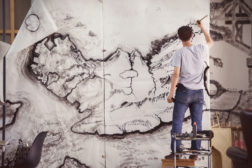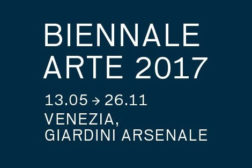Daring to Fail: Qiu Zhijie’s Consciousness for Experimentation
After almost two years, the series of conversations I had with artists based in Shanghai, which led to the project 40+4, still are a source of incredible inspiration. For this reason, I cannot avoid starting with reflections that arose from that project.
In writing this text about Qiu Zhijie, I would like to begin with some general considerations that might be the best background to describe the complex personality of this artist. To do so, I will quote one episode that has impressed me more than anything while talking with another artist, Wang Xingwei. It was a simple correction in the use of the word “artist” in my question (When did you start calling yourself an artist 艺术家) that revealed the real complexity of the translation of “being an artist” in the Chinese language and the meaning of the artistic profession. Artist is commonly translated as yishujia (艺术家) but also as huajia ( 画家) or in older times also as the complex traditional artist wenren (文人).
The three terms – far from equivalent – can be translated as artist, painter and intellectual, but in a Chinese context, they reveal much more than a simple artistic practice and semantic area.
Far from being silly, this matter of translation opened a lot of questions in relation to the understanding of Chinese contemporary art and art in general. Starting from the assumption (that I feel is more and more wrong) that artists belong in some sort of special category, I finally realized that this sanctification of them is not only naïve, but also misleading.
Quoting what Shen Fan says in another interview:
“’Artist’ is an occupation, just like businessman, journalist, photojournalist, and interviewer. Compared with the traditional notion of art, it’s no longer art since it’s an occupation. So I think ‘contemporary artist’ is a kind of occupation.”
This tension between the artist-self and the public/social human condition of being a “professional worker” is maybe not true for Qiu Zhijie. This peculiarity positions him as a strange case in the contemporary art scene in China and makes him an intriguing person that trespasses above categories of artist, painter, and literati, to become a new “professional researcher”, almost a scientist of the contemporary socio-political condition of China herewith inclusive of the “occasional” artistic research, production and final public presentation.
The curatorial years, remapping the end of the 90’s
To understand the complexity of Qiu Zhijie’s world, I will focus on the earlier years of his work -during the middle-end of the ‘90’s- that shaped the contemporary art world in China, preparing it for its final internationalization in the last ten years. I will concentrate on a key example of his incredible rich career in the attempt to freeze some moments that modeled him as a key personality in the arts in China.
After the experimentation of the 80’s and beginning of the ‘90’s, and following the “blessing” from the international art system on Chinese artists (with all their luggage of Chinese symbolism and skilled craftsmanship), a new generation of artists came into the picture in the late ‘90’s to begin a new discussion about what contemporary art in China should explore and push forward.
This particular time was at the center of a long written conversation between Li Zhenhua, Qiu Zhijie and me commenting on the last ten years of artistic development in the territories of our artistic initiatives and research: Beijing and Shanghai. The analysis of this period focused on these two cities and the independent force that was behind a movement that I define as “post-communist activism.” In this essay, I will refer to this conversation frequently, quoting large sections of what Qiu Zhijie said on that occasion. So far, I think that this transcribed text (sometimes very dense and cryptic) is a great source of information to define and to describe the role of Qiu Zhijie in creating short-circuited “occasions,” fundamental in sculpting the future of contemporary art in China.
In this same conversation, many exhibitions reappear -exhibitions that I forgot or of which little documentation still exists- such as the video art exhibition that Qiu Zhijie together with Wu Meichun organized in 1996, Image and Phenomena-96′ Video Art Exhibition. In Qiu’s words, this exhibition brought video art into a new step of development, opening up a new chapter of video art by artists such as Wu Ershan, Jiang Zhi and Yang Fudong.
As Qiu describes, the last years of the 90’s “and the artistic atmosphere that was around Beijing and Shanghai at that time made me feel bored. At that time Zhu Qi or someone else I do not remember was curating an exhibition in Shanghai. For that exhibition, Yan Lei produced something that was titled, ‘Welcome Yan Lei to Shanghai’. […] Such “concepts” [and artworks] include examples of Yan Lei’s and Hong Hao’s as well as the one that I always cite: putting a note in the exhibition hall saying: ‘None of the works here is mine’. These things bored me to death then. Such works that tried to prove that he [Yan Lei] was more clever than others, than other artists, and of course they tried to prove that he was also more clever than the audience. Basically, there was no other content, no emotional content, no narrative content.”
There was increasingly a malcontent towards the artists and art from the 80’s that was becoming generally seen as static or too symbolically charged or to some extent “void.”
Some of the attempts by Qiu Zhijie, Cai Qing, Li Zhenhua and others in Beijing to push the boundaries of the artistic experience created new energy that for a few years energized China and created a strong debate in the art world and in the political organizations of the government. The exhibition Post Sense and Sensibility, Alien Bodies and Delusion was the epitome of this period together with the Shanghai Art For Sale. Both occurred in 1999.
As Qiu says:
“The real reason to do the Post Sense and Sensibilities is to oppose Conceptual art. […] I described this in the article I presented in the forum organized by Huang Zhuan in 1998 in He Xiangning Art Museum (何香凝美术馆) and that was called The Zone of Errors in Conceptual Art; […] In this article I systematically taunt such artistic concepts as mechanical worship, worship of boredom, worship of minimalism, things like a heap of apples slowly rotting away, the eyes of a chicken slowly dying, the extremely long shot that was called video art. After that, the revolutionary masses would rather stay home watching soap operas and MTV, and it’s much better watching commercials than see a chicken slowly die […]. If art has gone to that extent, it’s got a huge problem.”
and more:
“Post-sensibility is connected with the idea of impulse, connected with words/language and with occasions and finally with light. So to speak, post-sensibility is not an art phenomenon per se because it will not belong to one time, one area and one group of people.”
It was not a manifesto’s exhibition but somehow it became that because some of the works presented manipulated by media, curators and artists themselves for being shocking installations presenting morbid structures of human corpses and objects. Artists such Sun Yuan, Xiao Yu, Zhang Hanzi or Zhu Yu, used in many of their early works human parts to build alien bodies and to play with the horrific.
In my vision, this exhibition has a symbolic place to interpret some of the most significant characteristic of Qiu’s proceeding in making art (his work was presented in the exhibition) and in curating exhibitions. This specific duality is recurrent in his practice and somehow this exercise (making/curating) makes his practice a bliss and a “failure” at the same time.
It is a bliss because he has been able to keep his artistic practice alive and kicking, and he was never being pulled into a framework that could have killed his creativity (i.e. he was involved in the Long March creation as a project and later a space but was not “constrained” by the management of the space itself). It is a “failure” because it put him in a position of continuous experimentation, which I think is a fragile yet necessary position of critical view but puts him at the edge of the art system and art market as well.
Processing the past, reading the present and engaging with the Long March project
An important constant of Qiu’s work has been – and still is – the relationship with the past and the fascination for archeology. From that, Qiu derives the tools he uses in thinking and making the outcomes of his artistic research.
A clear example of this attitude is in the exhibition curated by Feng Boyi called Traces of Existence (1998). This exhibition presented works by Song Dong, Yin Xiuzhen, Wang Jianwei, Zhan Wang and Zhang Yonghe.
Qiu recalls the artwork he presented as follows:
“I intended to dig a very deep archaeological pit in which I would place television sets at different heights and different three-dimensional levels and the television sets would play crows flying […]. The workers spent a week trying to dig a hole but could not move it [winter in north of China is so cold!] unless they came in with an excavator but then who could afford excavators in those days? Eventually, they worked hard at it for over ten days, managing to get to a certain depth. Later on, I changed the previously recorded video to be something else about the history of the changes in the various strata of earth the workers dig out. This area used to be a waste pit, containing filthy water and rubbish. In this archaeological pit, I found a lot of things. I made them into museum objects and I displayed them in the exhibition hall.”
This recalling of the past or making an artificial re-construction (fiction) of the past is a recurrent theme in Qiu’s work. He is able to play with occasional/site-specific found objects and to make them part of a far more complex and articulated reality. Progressively his imagination brings him to bigger ideas that play with more complex concepts and technical aspects of the making of his art.
In this same direction, there is one work-in-progress that Qiu has initiated that has moved into a international realm, becoming in its final declination a gallery space: “the Long March Project, a walking visual display.” The project was initiated by Qiu in cooperation with Lu Jie and consisted in a series of artistic works that retrace the history of the Long March, a sort of “walking visual display,” as Qiu described it. While for Qiu it was an open project but somehow limited in time and directions, for Lu Jie the project became quickly a possible long term project: the Long March Space was soon created.
“The Long March Project (2002) had a different meaning for Lu Jie and I. For Lu Jie, it was a way to solve the ‘Chinese/Foreign” issue, something to do with internal and external issues in China and the legitimacy of this relationship. […] The idea behind the Long March project coincided with my desire of a curatorial experiment on a big scale and it was for me a possibility to link the elites and the bottom social stratum. […] For me, Long March, on one hand, was a large-scale curatorial experiment, and, on the other, a bottom-up “expansion.” That’s what I achieved in this project: my abilities in social investigation were greatly exercised, because for me Long March was in fact a large-scale investigation tout court.”
This attitude of researching as a collective exercise is something that has been always part of Qiu’s work. The need of going deeper into analysis, the pushing of others (students and artists alike), the somehow arrogant belief of making “turning points” in contemporary art, all represents an incredibly genuine intellectual research that brought Qiu’s art into uncertain territories or sometimes in controversial ones.
One of the values I see in Qiu’s practice is that he is not afraid of going against the politically correct attitude or even worse against the skepticism and dishonesty, which is so present in contemporary art.
One example above all was the catalogue for the Tibetan Investigation. I won’t go into details about the content and the position of Qiu’s on the matter, but it is sufficient here to say that the catalogue with the outcome of the project created great resistance from within:
“Foreigners at Long March Project rose in collective rebellion, refusing to do this catalogue called The Tibet Investigation. According to Lu Jie, Dai Wei (David Dong) held a position close to his, relatively neutral. There were other old foreigners who simply stopped working, finding my article too leftist and too Chinese for them to accept. Even the translation of meaning of words was problematic.”
I believe we are surrounded by a sort of fear of the change of perspectives and, like we said in a recent conversation with Li Zhenhua, I find that there is a common attitude (which I define as reactionary) of being afraid of opened discussions, exploring controversy and even accepting the opposite: there is a great danger of trying to always be “correct” in making predicaments especially when who is talking is artists.
Artists’ role is to give new perspectives and to contribute with new tools of analysis of the existence: by doing that artists are pushed into zones of silence that cause misunderstandings and emotional conflicts necessary to create new sense and hope for socio-cultural changes.
UCCA and the Nanjing Bridge
The last chapter of this article will present a Qiu’s ongoing project I assume has been sort of resolved with the last presentation in UCCA (Ullens Center for Contemporary Art), Beijing, 2009. The project is called Suicidology of the Nanjing Yangtze River Bridge.
This project (started in 2006) -fairly complex and articulated- is an accumulation of a progressive research on the suicides that took place on this bridge in the recent past. The Yangtze Bridge which is one of the Communist era’s major achievements becomes here the subject of an (anti)heroic research that sees this highly symbolic place as the stage for thousands of people’s ultimate act.
As described above, this process was complicated by Qiu’s natural inclination to make the research a practical series of artistic gestures and creations, all based on instinctive reactions to the history, data and psychological/philosophical knowledge of the artist.
The result has been a monumental installation in UCCA, articulated in subchapters and art works that tried to solve the historical and psychological drama of the suicidal acts.
If we go back to the earlier years, Qiu’s statement reveals his concerns about how contemporary art in China was developing. He says:
“Our imaginary foe of the first Post-Sense Sensibilit” exhibition was the notion of conceptual art. We were averse to how this notion was taking precedence over everything else in the popular art practice. By showing-off your intelligence and knowledge to others, such practice led conceptual art to degrade itself into a kind of “idea art.” To a great degree, this is merely a consequence of what the very terminology of “conceptual art” implicates. This term leads our attention to the content of the concept, rather than to the on-the-spot experience of art. Therefore, not only did we oppose bad conceptual art, we fought against “conceptual art” itself. Furthermore, we opposed every art form which had been bestowed in the name of art: the worship of the banal, the worship of extreme simplicity, the worship of the trivial, the worship of seriousness and the worship of humor, to name a few.”
We cannot but agree to the point that Qiu’s works are an emotional and intellectual experience that requires an attentive behavior by the audience: the observer is constantly solicited by visual/esthetical stimuli together with magical/cryptical information that dig into traditional symbolism or historical/philosophical references. It is like a big feast and an overwhelming experience that is never “purified” or “cleaned up.” Instead, the relationship of the artworks in-situ creates unexpected narratives that fascinate from an aesthetical to a technical point of view.
The monumental ink on papers (190 x 500cm) 30 Letters to Qiu Jiawa for instance express the feelings and hopes of a father for his child. The grandiosity of the format and the fascinating drawings together with the fragile testament that the 30 letters represent do not leave the audience indifferent.
On the other hand I used to have seventy-two different forms, a huge bamboo made installation (800 x 1500 x 200 cm), reveals Qiu’s need to refer to craftsmanship to make things real, touchable and present as objects of discovery that are so close to the archeological obsession of the object. The only reproach is that technically the realization of this piece and some other elements of the huge complex installation were not perfectly controlled leaving potentially amazing results only partially achieved. If this sort of “ritualistic” sloppiness is acceptable in an independent/underground situation, it is not adequate in an art center that strives to become a sanctuary for contemporary art like UCCA has proved to attempt to.
To conclude, in Suicidology of the Nanjing Yangtze River Bridge, 3 we can find all that has made Qiu’s progressive art theory consistent in making what Qiu labels as “Total Art:” “I defined [Total Art] as the art of cultural research. As result and through the process of researching, art would finally reveal itself in situ [exhibition/presentation] in a synthetic manner, and in such form art would eventually make its place in history.”
Davide Quadrio, Pergola, July 2009




